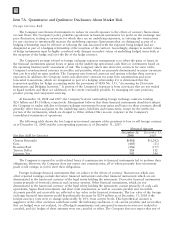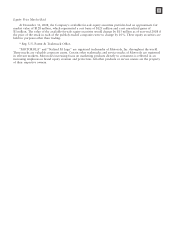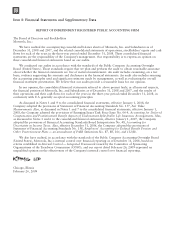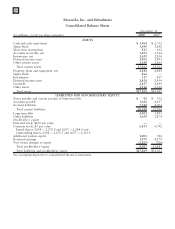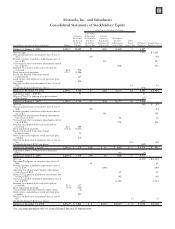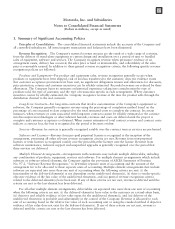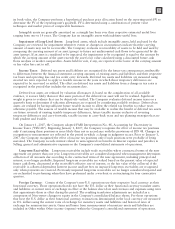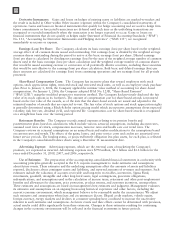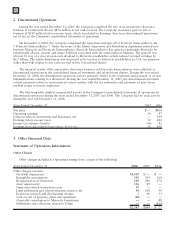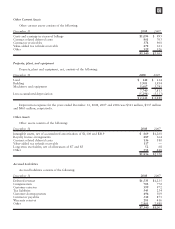Motorola 2008 Annual Report Download - page 96
Download and view the complete annual report
Please find page 96 of the 2008 Motorola annual report below. You can navigate through the pages in the report by either clicking on the pages listed below, or by using the keyword search tool below to find specific information within the annual report.
When elements of an arrangement are separated into more than one unit of accounting, revenue is recognized
for each separate unit of accounting based on the nature of the revenue as described above.
Sales and Use Taxes—The Company records taxes imposed on revenue-producing transactions, including
sales, use, value added and excise taxes, on a net basis with such taxes excluded from revenue.
Cash Equivalents: The Company considers all highly-liquid investments purchased with an original maturity
of three months or less to be cash equivalents. At December 31, 2008, and 2007, restricted cash was $343 million
and $158 million, respectively.
Sigma Fund: The Company and its wholly-owned subsidiaries invest most of their U.S. dollar-denominated
cash in a fund (the “Sigma Fund”) that is designed to provide investment returns similar to a money market fund.
The Sigma Fund portfolio is managed by four premier independent investment management firms. The investment
guidelines of the Sigma Fund require that purchased investments must be high-quality, investment grade (rated at
least A/A-1 by Standard & Poor’s or A2/P-1 by Moody’s Investor Services) U.S. dollar-denominated debt
obligations, including certificates of deposit, commercial paper, government bonds, corporate bonds and asset-
backed and mortgaged-backed securities. Except for debt obligations of the U.S. treasury and U.S. agencies, no
more than 5% of the Sigma Fund portfolio is to consist of debt obligations of a single issuer. The Sigma Fund
investment policies further require that floating rate investments must have a maturity at purchase date that is not
in excess of 36 months with an interest rate that is reset at least annually. The average interest rate that is reset of
investments held in the Sigma Fund must be 120 days or less.
Investments in Sigma Fund are carried at fair value. The Company primarily relies on valuation pricing
models and broker quotes to determine the fair value of investments in the Sigma Fund. The valuation models are
developed and maintained by third-party pricing services, and use a number of standard inputs, including
benchmark yields, reported trades, broker/dealer quotes where the counterparty is standing ready and able to
transact, issuer spreads, benchmark securities, bids, offers and reference data. For each asset class, quantifiable
inputs related to perceived market movements and sector news may also be considered in addition to the standard
inputs.
The Company considers a decline in the fair value of a security in Sigma Fund to be temporary if it believes
that it will collect all amounts it is owed on the security according to its contractual terms, which may be at
maturity. If it becomes probable that the Company will not collect all amounts that it is owed according to a
security’s contractual terms, it considers the security to be impaired and adjusts its cost basis of the security by the
related impairment loss. Beginning in the fourth quarter of 2008, all changes in the fair value of Sigma Fund
investments, including temporary unrealized gains (losses) and impairment charges, are recorded in Other within
Other income (expense) in the Company’s consolidated statements of operations.
Investments: Investments in equity and debt securities classified as available-for-sale are carried at fair value.
Debt securities classified as held-to-maturity are carried at amortized cost. Equity securities that are restricted for
more than one year or that are not publicly traded are carried at cost. Certain investments are accounted for using
the equity method if the company has significant influence over the issuing entity.
The Company assesses declines in the fair value of investments to determine whether such declines are other-
than-temporary. This assessment is made considering all available evidence, including changes in general market
conditions, specific industry and individual company data, the length of time and the extent to which the fair value
has been less than cost, the financial condition and the near-term prospects of the entity issuing the security, and
the Company’s ability and intent to hold investment until recovery. Other-than-temporary impairments of
investments are recorded to Other within Other income (expense) in the Company’s consolidated statements of
operations in the period in which they become impaired.
Inventories: Inventories are valued at the lower of average cost (which approximates computation on a
first-in, first-out basis) or market (net realizable value or replacement cost).
Property, Plant and Equipment: Property, plant and equipment are stated at cost less accumulated
depreciation. Depreciation is recorded using straight-line and declining-balance methods, based on the estimated
useful lives of the assets (buildings and building equipment, 5-40 years; machinery and equipment, 2-10 years) and
commences once the assets are ready for their intended use.
Goodwill and Intangible Assets: Goodwill is not amortized, but instead is tested for impairment at least
annually. The goodwill impairment test is performed at the reporting unit level and is a two-step analysis. First, the
fair value (“FV”) of each reporting unit is compared to its book value. If the FV of the reporting unit is less than
88


